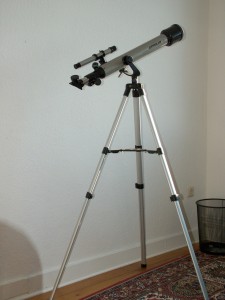 Am Anfang war… ein Sonderangebot von Aldi. Ein Teleskop für € 39,95. Kann nichts taugen. Für das Geld kann man aber auch nicht viel falsch machen. Also habe ich ein Exemplar erworben. Seitdem haben andere Discounter ähnliche Angebote gehabt, oft mit weit besserem Gerät, aber 2007 war das das erste Teleskop, das für so ein Geld angeboten wurde.In the beginning there was… a special offer by ALDI. A telescope for EUR 39,95. At that price, it cannot be good for anything. On the other hand, for that amount of money, there is little one can do wrong. So I got an example. Since then, other discount chains have had similar offers, often with far better hardware in the package, but in 2007 this was the first budget telescope offered, full stop.
Am Anfang war… ein Sonderangebot von Aldi. Ein Teleskop für € 39,95. Kann nichts taugen. Für das Geld kann man aber auch nicht viel falsch machen. Also habe ich ein Exemplar erworben. Seitdem haben andere Discounter ähnliche Angebote gehabt, oft mit weit besserem Gerät, aber 2007 war das das erste Teleskop, das für so ein Geld angeboten wurde.In the beginning there was… a special offer by ALDI. A telescope for EUR 39,95. At that price, it cannot be good for anything. On the other hand, for that amount of money, there is little one can do wrong. So I got an example. Since then, other discount chains have had similar offers, often with far better hardware in the package, but in 2007 this was the first budget telescope offered, full stop.
Also habe ich es gekauft. Billigplastik-Koffer mit Billigplastik-Tubus, Kellner-Okularen die weit jenseits jeglicher Vernunft sind, und Dokumentation, die den Kaufpreis allein aufgrund ihrer unfreiwilligen Komik rechtfertigt. Denn im Paket ist ein Heftchen enthalten das die Vorzüge des Teleskops anpreist. Unter anderem heißt es darin, dass man den “Mond des Jupiter ‘Galileo’” sehen könne. Die vorletzte Seite derselben Broschüre enthält eine Mondkarte, die mich aufgrund ihrer Qualität (bzw. des vollständigen Fehlens derselben) am Geisteszustand der Autoren zweifeln läßt. Selten habe ich bei einem vorgeblich kartographischen Werk mit einem Blick die Anzahl der Pixel zählen gekonnt. Hier geht das problemlos.
Also was wurde angeboten?
Ein Refraktor mit 60 mm Öffnung und 750 mm Brennweite. Das ist beides nicht viel, aber besser als ein Feldstecher. Dazu vier Kelllner-Okulare, mit 20, 12,5, 6,5 und 4 mm Brennweite. Rein rechnerisch also bis zu 187fache Vergrößerung, was bei der Öffnungsweite schlichter Größenwahnsinn ist. Jedenfalls auf keinen Fall sinnvoll. Dazu ein so genannter “Mondfilter”, der eigentlich nur ein Grünfilter ist, und eine 1,5fach Barlow-Linse. Damals wusste ich es noch nicht, hatte aber schon den Verdacht: Barlow-Linsen sind Scheiße. Egal wie gut sie sein mögen, sie täuschen eine Vergrößerung vor die rein optisch eigentlich nicht drin ist. Die zusätzliche “Vergrößerung” durch eine Barlow-Linse ist letztlich Illusion, die Drehung des Bildes vielleicht der einzige sinnvolle Effekt.
So I bought it. Cheap plastics case with cheap plastics tube, Kellner eyepieces way beyond any reasonable magnification factor, and documentation which managed to justify the buying price on its own for the sheer, if unintended, comedy value. Because it included a brochure praising the telescope’s capabilities. The brochure, among other claims, states that with this ‘scope, one can actually observe the moon of Jupiter named “Galileo.” The Galilaean moons, OK, but so far I have not managed to see that one.
The next to final page of the same brochure contained what the printer called a “moon map,” which due to its complete lack of any quality whatsoever made me doubt that the printers had anything even remotely approaching sanity. Rarely have I been able to count the pixels of a supposedly cartographic publication with a single look. This one made it easy.
So what was in the package?
A refractor telescope with 60 mm aperture and 750 mm focal length. That may not be much, but still a far cry from an opera glass. Also in the package were four Kellner eyepieces with 20, 12.5, 6.5 and 4 mm focal length. Purely mathematically, that would offer up to 187 times magnification, only given the aperture of this thing, that’s just plain idiocy. Also, a so-called “moon filter” is in the package, which actually is a dark green filter, and a 1.5fold Barlow lens. Back then I did not know it, but already had this nagging suspicion: Barlow lenses are garbage. No matter how good the optics are, a Barlow lens only tries to increase the magnification past what the primary optics (i.e., the telescope proper) can do. Can’t be done honestly; the seemingly larger magnification from a Barlow lens is pure illusion, and its only real benefit is that the image is turned around in the eyepiece.
